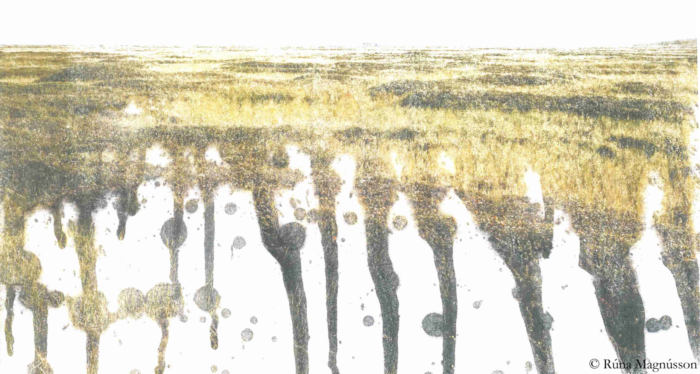
Whether they are natural occurrences or experimentally induced, permafrost and Arctic ecosystems are responding fundamentally to recent climate extremes. Good writing and statistics material for us scientists, but bad news on pretty much every other level. Are we effectively communicating how fundamental these changes are? And can we use our personal experiences, stories and artwork to support us in our communication?
I remember the excitement when my colleague Ron and I did our final round of permafrost thaw depth measurements on the Siberian tundra before going home in the summer of 2018. We had done an irrigation experiment to see how heavy rainfall affected permafrost thaw. In half of our measurement sites, we had supplied additional rain, the other half was left as is as a control. “Oh, this is definitely going to be a significant difference!” we said, as we noticed that the permafrost had thawed much deeper in irrigated sites, and shallow water layers started to appear on top of the frozen subsoil. Good news for publication opportunities, but bad news for the permafrost, as extreme rainfall events are projected to increase across the Arctic. Our excitement immediately felt very misguided. Even when I went back in 2019, the permafrost was still degrading faster in previously irrigated sites. In the years after the pandemic and war in Ukraine forced us to stay at home and make do with the data we already had. We had many more monitoring activities and experiments running in the North-Eastern Siberian tundra. I have often wondered how we can keep the beautiful and vast permafrost ecosystems of remote Siberia – and all the carbon they contain and livelihoods they sustain – on our collective agenda. In this blog I will share some of my research into rainfall effects on permafrost ecosystems, and the artwork I have created during this journey. Because – in a nutshell – I think we’re going to need more ways to connect to the Arctic and its changing climate apart from significant findings and impactful publications.
Making it happen
In my toolkit as a researcher, controlled experimental set ups in the field are one of my favourites. By performing experiments, we can mimic expected changes to the local climate or ecosystems locally and in a controlled way, so that we can produce knowledge of climate change impacts on permafrost and polar ecosystems in an early stage. They also give us more insight into causal relations compared to measures of correlation between for instance air temperatures and permafrost thaw, because we always have a so-called control treatment to compare our observations to. The Arctic is changing rapidly and hence the changes you could simulate as a permafrost and tundra researcher are numerous. Warming experiments are an obvious example. You could also remove or add snow in winter or remove part of the vegetation and see what that does to permafrost. (Hint: it messes with the insulation!). It is also worthwhile to see whether you see different behaviour if you combine multiple changes; does warmer and wetter result in different behaviour than warmer and drier? Probably!
My own mission was to use irrigation to simulate heavy rainfall events (see photo below), which are expected to occur more frequently in the future Arctic. As I started setting out my series of experiments with increased summer rainfall it also forced me to think about what rainfall really entails and how it occurs, so that I could mimic it properly. How much rain can realistically fall within a single day and how does that differ between Arctic climate zones? What is the chemical composition of rainwater in my study area? This forces me and my colleagues to develop a deeper understanding of the climatic changes we’re trying to simulate.

Our irrigation set-up on the tundra in action, with the Chokurdakh Scientific Tundra Station in the background. We irrigated 10 experimental fields, circles of 5m diameter, and left 10 others “as is” for comparison. [Credit: Rúna Magnússon]
The missing link
In purely academic sense, our research into rainfall effects in Siberia was a success: it yielded nice publications, some media coverage and inspiration and opportunities to carry forth the experiment in new areas. I am very grateful for this. At the same time, I often felt that something had been missing. I started my PhD in polar research out of an intrinsic love and deep sense of connection to northern ecosystems. In this line of work, your love for your research subject, experiences and findings eventually have to pass through the academic filter of quantifiability, robustness, representativeness, significance, etcetera. There are very good reasons for that of course. And yet, before you know it, all the remarkable specific details and personal sense of wonder and connection are filtered out. For Arctic communities, and at some point for us Arctic researchers too, the reality of tundra ecosystem changes and degradation of permafrost are much more fundamental and personal than our forecasts and p-values. You start to see fundamental shifts in the landscape from frozen to thawed, between hard and soft, alive or dead, in sync or out of sync, safe or unsafe. It usually defies my attempts to describe it elegantly, but Charlotte Wrigley writes about it beautifully in her recent book “Earth, Ice, Bone, Blood”.
Particularly during lockdowns, with no opportunity to travel to the tundra, I started longing to give all these things a place and outlet of their own. I’m becoming more and more convinced that our experiences and feelings of wonder are as important as scientific findings, because our human experiences and emotions allow a much broader range of people to connect with our research and with nature. Below, I will share some of my artwork and photography (www.runamagnusson.com) as an invitation to connect to the frozen landscapes of the north.
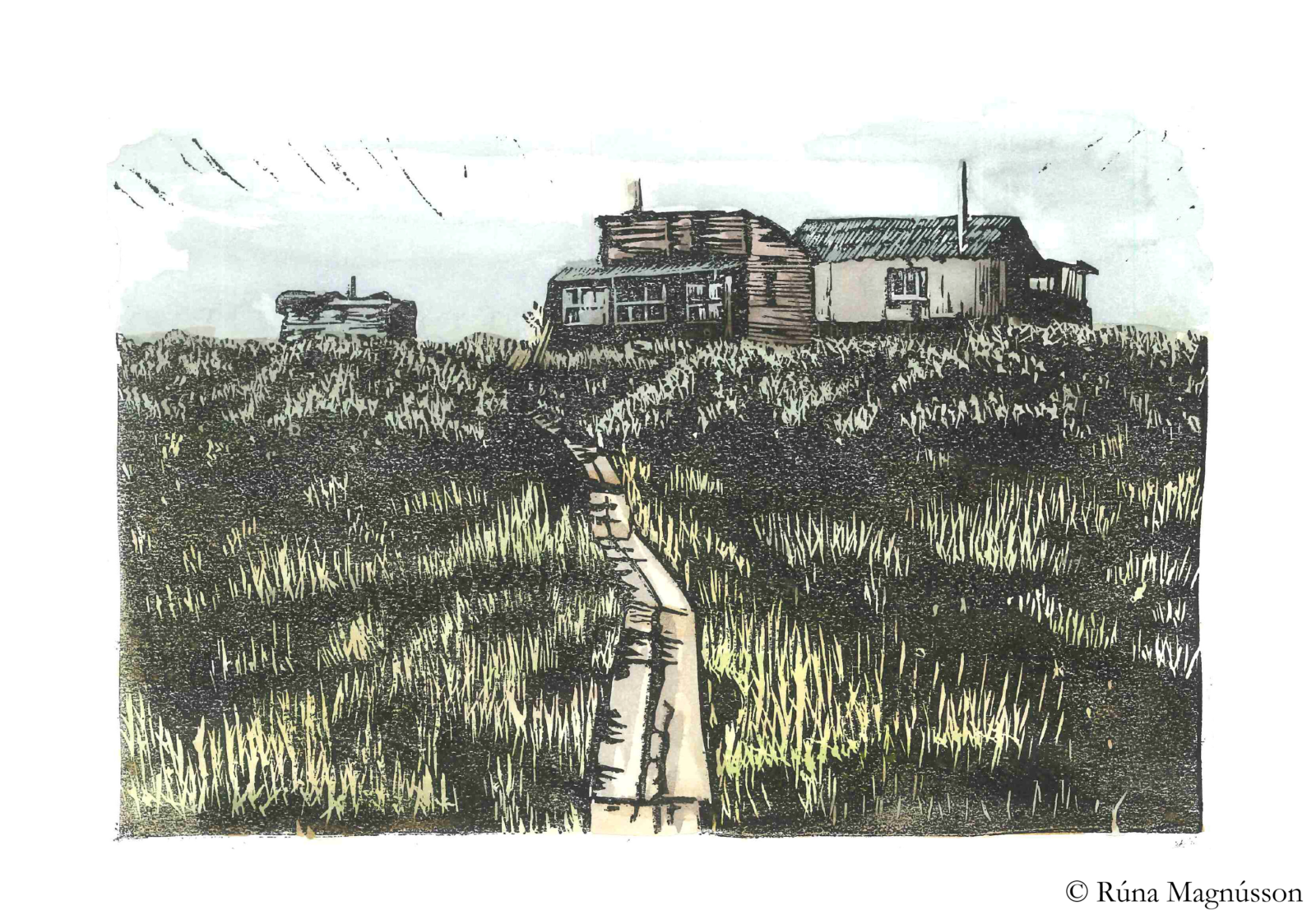
Linocut and aquarel of the Chorkudakh Scientific Tundra Station, seen from the floodplains of the Berelekh river. A very remote place, that I tried to keep close by painting it. https://arcticresearch.wordpress.com/2019/07/15/letters-from-kytalyk-part-i/
Most people have never seen the polar regions. Except for those that are permanently based at the poles, access to the polar regions for researchers can also be quite scarce, expensive and challenging. Students regularly ask me if they can do a field project in the Arctic with me and it makes me sad that I have to disappoint so many of them. I also regularly faced this disappointment myself, thinking “oh, if I could just go back really quick to measure this one little thing”. Or when I longed to go back to the tundra but couldn’t. So we feel an immense pressure to get the most out of it in the periods that we can be there, and for most of us the polar regions will always be elusive and far away.
But we very much need our eyes and ears in the polar regions, from indigenous communities as well as visiting researchers and adventurers. Numerous changes in the Arctic have the potential to affect the global climate and our common future, such as loss of sea ice and ice sheets and release of greenhouse gases from thawing permafrost. So, from a physical climate perspective, our connection to permafrost ecosystems is very evident. But only few people on this planet are permafrost experts or climate physicists. So how do we foster a deeper connection to a faraway region that has such an important role in our future, and a region that has so much beauty? And is a rational connection enough? Shouldn’t we also share the beauty, images and lived experiences of our work directly, rather than only the numbers?

Linocuts of Arctic bell-heather (Cassiope tetragona) and the Svalbard poppy (Papaver dahlianum). Arctic ecology is often a matter of scale. Stand upright and the landscape seems empty and sparsely vegetated. Lie down with your face close to the ground and a beautiful micro-universe of mosses and small delicate flowers opens up around you.
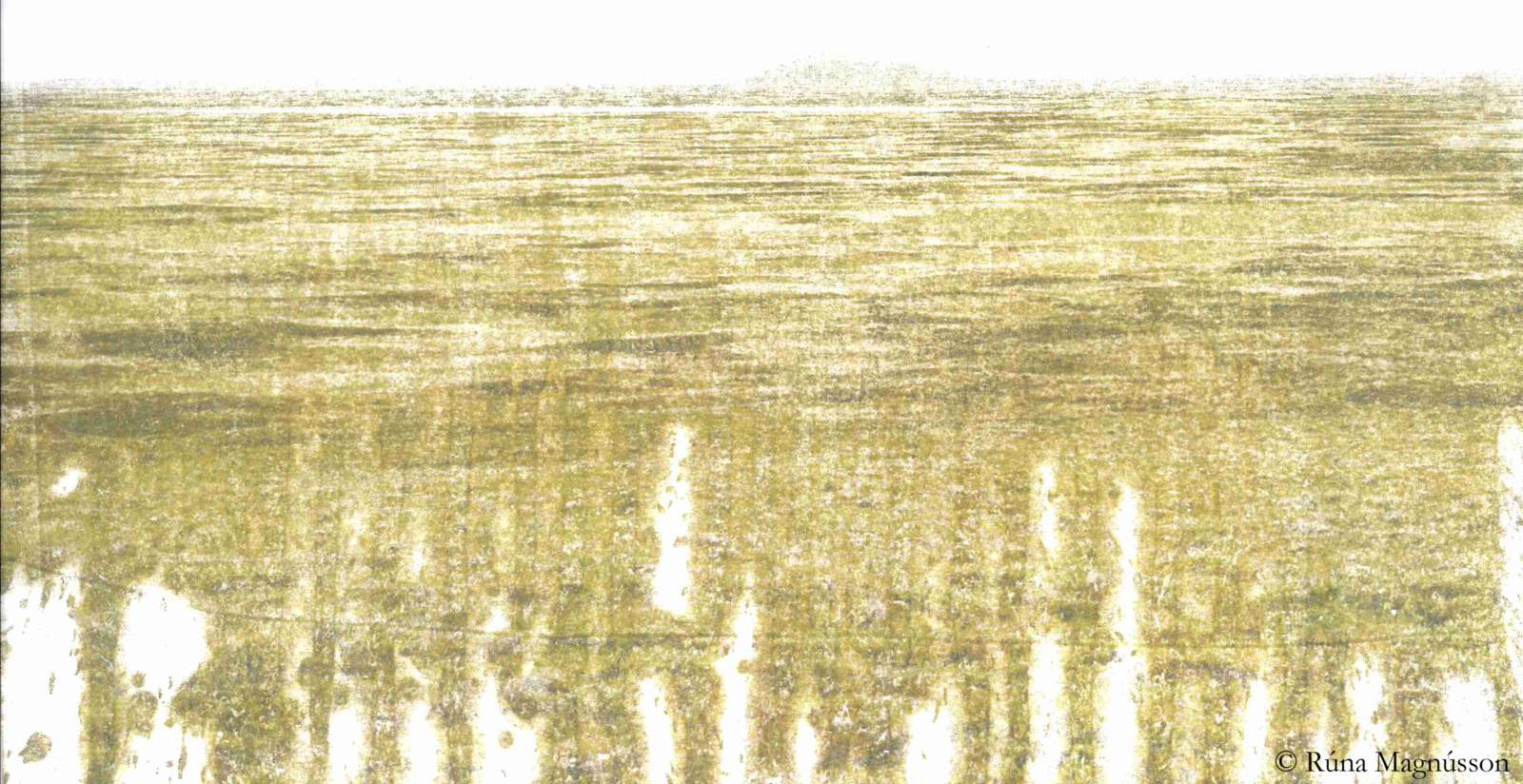
Acetone transfer print of a photograph of the Siberian lowland tundra landscape. The dripping and fading colours show how the thawing of permafrost is a drastic change in the very foundation of the ecosystem, as frozen soil and ground ice become soft and liquid and start to subside and flow.
Illustrating to support polar science
I think we do, and that is why I want to share my tundra inspired art pieces. The idea for the acetone transfer prints like the one shown in the featured image originated when I was standing at the foot of a thawing and eroding permafrost cliff at a lakeside in Siberia in 2019. I could see the huge ice bodies in the ground melt in the sun, smell the rotting organic materials in the ground and hear the constant dripping and splashing as more ground and water fell down and flowed as mud down the cliff (see photo below). This was a huge “duh” moment for me. Permafrost is usually hidden underground, and its degradation is often described in mechanistic or mathematical ways. We could all use a moment like this to get a sense of what permafrost actually is and what it is doing in a warming climate; what does it look like? Where does all this sediment, water and carbon go once the ground thaws? We may not all know what a thaw slump is, but we intuitively understand concepts like melting of ice, rotting smells and flow of soil and water based on shared human experiences. When I talk about my research with friends outside of my very specific academic niche, I see how these stories and specific experiences based on shared senses and experiences enable us to connect and understand, rather than me trying to explain my experimental design and statistics. If us scientists could share such experiences and make abstract aspects of the cryosphere more tangible, alongside our scientific outputs, we might be surprised how much impact our experiences can have. I invite you to try it; do you remember that one impactful personal moment during fieldwork, that one beautiful plant or rock? Draw it, tell us about it! Allow us to connect.

Water and mud were slowly dripping down from this exposed permafrost cliff in a Yedoma ridge by a lake some hours walking distance from the Chokurdakh Scientific Tundra Station in North-Eastern Siberia (August 2019). The soil contained ice wedges of several meters wide and many more meters tall (they were taller than us and we could not see the bottom). [Credit: Rúna Magnússon]

Linocut of one of my new fieldwork locations in Endalen, Svalbard. The wooden structures are remnants of the cable cart systems that were in use to transport coal from the mines to the harbour. These days they are strange fossil monuments in the most rapidly warming place on Earth.
Further reading
Also in boreal Alaska, heavy summer rainfall was found to accelerate permafrost thaw: https://www.nature.com/articles/s41612-020-0130-4
In this preprint, my colleague Alexandra Hamm (Stockholm University) discusses how impacts of rainfall on permafrost may vary across Arctic regions: https://assets.researchsquare.com/files/rs-2237155/v1/3e41a253fb2ebda0cf79760d.pdf?c=1668997497
Previous Cryosphere & Art blogs on an art and science collaboration about listening to permafrost and with permafrost haikus.
Edited by Loeka Jongejans
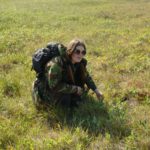 Rúna Magnússon is an early career lecturer and researcher at Wageningen University, the Netherlands. Besides teaching various courses in plant ecology and nature conservation, she studies impacts of extreme rainfall events on permafrost and tundra ecology in Svalbard. In her PhD she studied permafrost degradation, shrub growth and vegetation succession under climatic change at the Chokurdakh Scientific Tundra Station. Furthermore, along her research and photos, she shares her passion of the Arctic in the form of illustrations on www.runamagnusson.com. Email: runa.magnusson@wur.nl
Rúna Magnússon is an early career lecturer and researcher at Wageningen University, the Netherlands. Besides teaching various courses in plant ecology and nature conservation, she studies impacts of extreme rainfall events on permafrost and tundra ecology in Svalbard. In her PhD she studied permafrost degradation, shrub growth and vegetation succession under climatic change at the Chokurdakh Scientific Tundra Station. Furthermore, along her research and photos, she shares her passion of the Arctic in the form of illustrations on www.runamagnusson.com. Email: runa.magnusson@wur.nl

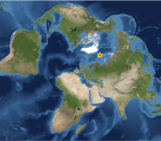
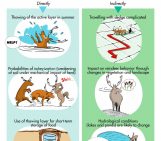
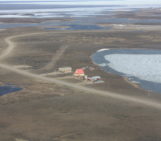
Teknik Telekomunikasi
What year did the final round of permafrost thaw depth measurements take place?